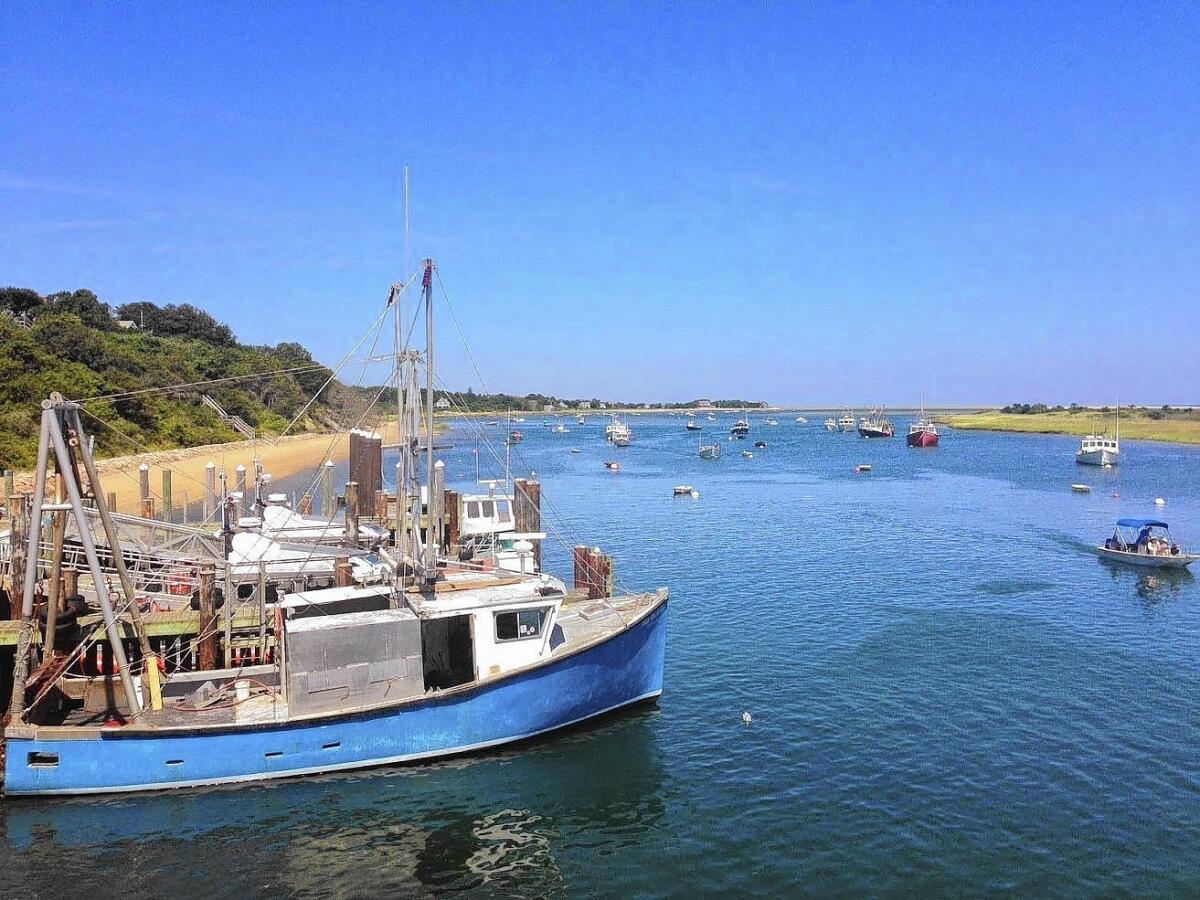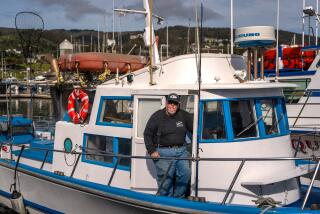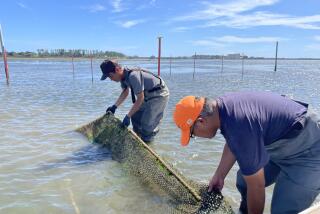Cape Cod’s namesake fish population rapidly disappearing

- Share via
Reporting from Chatham, Mass. — There aren’t enough cod left on Cape Cod.
That soon becomes evident to the tourists crowding an observation deck to watch fishermen unload their boats in this picturesque harbor sheltered from the ocean by sandy dunes.
Today’s catch: pounds of skate, a fish that looks like a sting ray until fishermen catch it, when they cut off its wings and throw the body back into the water. The skate wings, white triangular pieces of flesh trailed by streams of blood, slide down ramps onto the loading dock.
“Eeeewww,” says 5-year-old Felix Haight. “It looks like raspberry jelly,” he adds, as his mother wrinkles her nose.
The next boat brings in dogfish, which looks like a mix between a shark and a lizard, and is no more appealing to the tourists.
For generations, the fish sliding down this ramp would have been cod, a ground fish that has been caught in these parts since the Pilgrims landed on Cape Cod, and before. But for reasons that scientists are still trying to determine, the cod population, shrinking for decades, dropped off precipitously in the last few years.
Last year, commercial fishermen caught just 2 million pounds of cod in the Gulf of Maine, which stretches from Nova Scotia to Cape Cod, down from 13.1 million pounds in 2009. Two decades ago, fishermen hauled in 30.5 million pounds.
Some fishing regulations have been put in place over the decades to prevent overfishing, but recently, fishermen couldn’t even reach the annual limit of 14 million pounds.
“It really fell apart in the last two years,” said Greg Walinski, who has made a living fishing in Cape Cod for 35 years. “We’re at the point now where it’s become economically impossible to do it.”
While other once-overfished populations such as haddock are rebounding, the news about cod has gone from bad to worse.
This month scientists with the National Oceanic and Atmospheric Administration wrote that their new analysis “presents a grim picture for the potential recovery of the iconic fish stock.” The amount of fish big enough to spawn off the Gulf of Maine is at 3% to 4% of normal levels, the scientists said.
Experts are planning to meet Thursday and Friday to review the analysis and try to figure out what to do next.
The decline of the fish has dealt an economic blow to the hundreds of Cape Cod fishermen who used to spend their whole year catching cod. Most have switched to skate and dogfish, which are often canned and shipped to Europe. Some have given up fishing in the winter to work construction; others have left the industry entirely.
Walinski is one of the lucky ones who still fishes year-round, bringing in bluefin in the summer and dogfish the rest of the year. But the dogfish market is so saturated that fishermen only get around 20 cents a pound. By contrast, when Walinski can find cod, he can get $4.50 a pound.
Many of the fishermen blame the National Marine Fisheries Service. They say that big trawlers were allowed to decimate the cod population and that the cod fishery was badly managed.
Some also blame the seals that have become ubiquitous around Cape Cod. Seals pilfer from fishing nets, eating the bellies out of the cod and ruining catches, said John Tuttle, who has fished out of Chatham for 37 years.
“When I started fishing, you’d never see a seal,” Tuttle said. “It was cod everywhere, beautiful cod and haddock everywhere.”
He and others advocate for changes to the Marine Mammal Protection Act of 1972, which prohibited the killing of marine mammals. Over the decades the seals have made a comeback.
But scientists say there’s no evidence tying the increased seal population to the decline in cod stocks. Centuries ago, seals and cod used to coexist in abundance, until the seals were hunted down. Besides, there aren’t enough cod in the bellies of seals that scientists study to indicate they’re solely feasting on cod, said Russell Brown, the deputy science and research director of NOAA’s Northeast Fisheries Center.
There’s no easy explanation for what is happening to the cod, Brown said. Adult cod are barely reproducing in Gulf of Maine waters, though scientists aren’t sure why. They are looking into what role warmer water temperatures of recent years might have on fish and their food sources.
There’s one reason to be optimistic: the haddock revival of the last decade, which followed a decade in which the fish nearly disappeared.
The population’s rise was driven by new daily catch limits and regulations requiring nets that allowed smaller fish to swim free and eventually breed. Some of the haddock’s resurgence can be attributed to luck, too; in 2003, for reasons scientists are still trying to puzzle out, there was a haddock baby boom.
“We’ve rebuilt a lot of stocks, including haddock,” Brown said. “It takes a lot of sacrifice and a lot of diligence.”
Meanwhile, fishermen off Cape Cod are trying to adjust to a life without cod. It’s a strange transition.
After all, New England was built on cod. Rosy reports of the amount of fish in the water were one of the reasons the pilgrims set out for North America. Once they learned how to fish, the industry boomed, allowing early Cape Cod residents to trade cod for goods overseas and build big houses, which they sometimes decorated with images of the fish, according to Mark Kurlansky, author of “Cod: A Biography of the Fish that Changed the World.”
The Cape Cod Commercial Fishermen’s Alliance is launching a campaign to encourage Americans to eat more dogfish and skate, because most of the New England catch is now exported and used for dishes such as fish and chips in England. They’ve hosted tastings to show consumers that dogfish can be delicious, finding chefs to cook up recipes including pancetta-wrapped dogfish with Brussels-sprout slaw.
The next step may be rebranding the dogfish, said John Pappalardo, executive director of the alliance. After all, Chilean sea bass used to be known as Patagonian toothfish; dogfish could be rebranded New England white fish or a name that might make it more appealing to consumers.
With a new name, consumers might be able to look past the fish’s appearance.
“It’s not the most attractive fish to look at,” Pappalardo said. “But neither is a lobster.”
Consumers may have to skip the fish pier in Chatham, if they’re going to be persuaded to eat dogfish and skate, however. Between the recent caws of the sea gulls and the wind rocking the boats moored in the harbor, there was another consistent sound off the Chatham docks: that of tourists groaning with disgust again and again as slippery dogfish and bloody skate wings slid on by.
More to Read
Sign up for Essential California
The most important California stories and recommendations in your inbox every morning.
You may occasionally receive promotional content from the Los Angeles Times.











